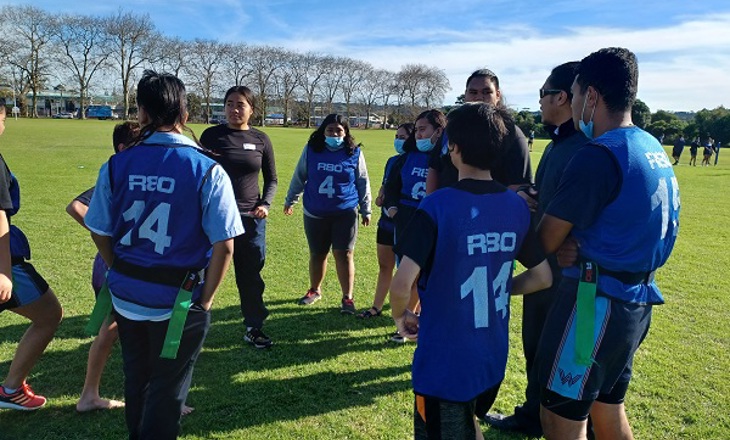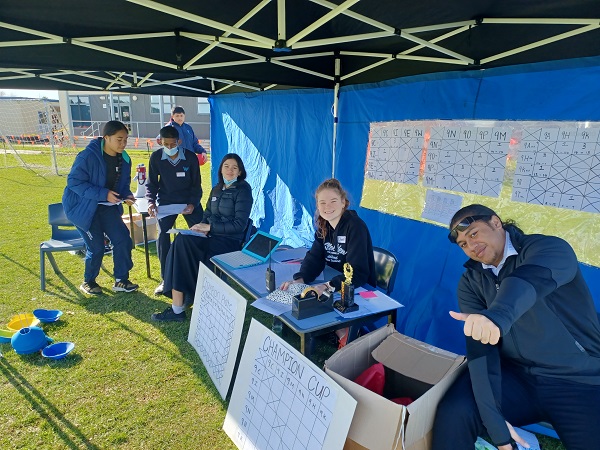Voice of Rangatahi Insight to Action project Case Study
Voice of Rangatahi Insight to Action project Case Study
Case study: Waitākere College

Sport NZ’s Voice of Rangatahi (VoR) programme, undertaken for the past four years, provides secondary schools with a tool to survey students to understand their experiences of physical activity within the school setting.
To support this, a VoR Insight to Action project was set up in 2020 to support Regional Sports Trusts and Regional Sports Directors to identify opportunities from the VoR data to improve physical activity experiences within the school setting.
Taking a student-led approach and using the VoR survey, Waitākere College linked the project with the Year 13 health curriculum ‘Health Promotion’ standard. Year 13 students surveyed their Year 9 peers following the VoR approach. The students learned to analyse and apply the insights gathered, to prioritise actions that could improve rangatahi experiences in 2021 and 2022.
Insights – the starting point
West Auckland has had the lowest participation rate in secondary school sport across New Zealand for over 20 years. This context gave Waitākere students the opportunity to extend their insights on the level of secondary school participation and problems that exist.
The Year 13 students used the VoR data that was collected from the school in 2020 as well as New Zealand Secondary Schools Sports Council (NZSSSC) census data from recent years to identify key projects that would address the barriers or issues identified in the data.
Identifying an issue
Waitākere College Head of Physical Education Philip Brain says that it is important to see what the students want to do to solve the problem. He encouraged the students to identify an issue they want to address and solve it in the way they want to solve it.
Philip added that self-motivation was the key to the students’ success in the project.
“I want them to want to do it,” he said. “It’s pretty cool when it comes from the students themselves.”
The projects
Students worked in groups to develop their concepts. Of the five projects pitched to Regional Sport Director and Women and Girls Lead at Sport Waitākere, Casey Redman, two were chosen.
- Changing room facilities
Address the state of changing room and bathroom facilities in the gymnasium space through:
- developing and upgrading the changing room and bathroom facilities located in the gymnasium
- creating a school sport hall of fame in the changing room facilities that promotes dux students, national representatives and sports captains.
- Increasing participation
Increase the range of participation opportunities on offer through delivering a:
- Kī-o-rahi tournament
- female self-defence class.
Casey helped the students apply for Tū Manawa funding, which the students successfully received for both projects.
Project one – changing room facilities
The students identified the changing room facilities as a major barrier or negative influence that discourages participation in sport at Waitākere College.
According to research, 32 percent of students in the Sport Waitākere region were put off participating in sporting events because of the school’s inability to maintain a clean changing room environment.
Student comments included:
“They need to be cleaned more and it needs to be more hygienic.”
“No point in having doors because you can’t use them.”
“Covered in graffiti.”
“I would like to see them improve by being cleaner.”
Key steps
The students met with their peers to gather ideas around the new design and layout and allocated budget. With further investment from the school, they brought the designs to life.
The upgrade included fixing broken fittings, installing better handwashing facilities, painting the space and installing custom vinyl imaging on the walls. The designs reflect the school’s colours and values, with positive quotes and sports imagery included.
They added wall designs of previous Dux students, national representatives and sports captains through the entrance of the PE department. Framed jerseys celebrating the achievements of student athletes were also included, creating a museum feel.
Project two – increasing participation
The VoR also highlighted a need to provide more and diverse opportunities for participation. Working with a group of female students, the school identified some form of martial arts or self-defence as a good fit.
A second group shared the following comments to consider when shaping new opportunities for participation:
“Adding more things that we can play.”
“Give more sports a try like skateboarding, BMX and other sports.”
“More physical sports, MMA classes.”
The students identified a Kī-o-rahi tournament as a culturally responsive way to get active at school.

Key steps
Female self-defence classes
The students organised a female self-defence class, hosted as a mother-daughter workshop, which was a huge success. Fifty students and parents attended (with more registered who were unable to attend due to Covid). The school received a great amount of positive feedback and were asked to deliver additional workshops in the future.
Kī-o-rahi
Students also planned a Kī-o-rahi tournament for junior students. Kī-o-Rahi Tāmaki Makaurau upskilled the Year 13 class to run the game, including how to teach the rules and tikanga, to ensure the participants understood the stories behind the game.
After the tournament was postponed due to Covid in 2021, the 2022 Year 13 students stepped in and decided the best timing to have it was to coincide with Matariki in June 2022.
Tournament debrief
To debrief, students followed the Action Competence Learning Process (ACLP) seven step process: Identify the issue; develop learning and insights; develop a vision, brainstorming possible solutions; understanding; planning; acting; and refining and evaluating.
Philip emphasised the importance of students reflecting and evaluating along the way. Through this process, students considered ‘what went well’ and ‘what didn’t go well’.
On the morning of the event, the Year 13 students had to redo the draw when one team was forced to withdraw due to COVID. Mr Brain said that the students became a bit argumentative during the re-draw process. He explained, “This showed passion. If it didn’t matter, the kids wouldn’t have gotten worked up. They felt it was important to argue the point on some things. It obviously felt very real.”
The ACLP process serves as a cycle, encouraging students to finish refining and evaluating by identifying issues once more.
Measuring success
At this stage, the data available has been anecdotal rather than quantitative. Waitākere College remains committed to redoing VoR to fully understanding the impact of their actions through this project.
Changing room facilities
Former students have been motivated to donate memorabilia as part of the school sport hall of fame. Past and present students’ and teachers’ accounts speak to the nostalgia and sense of community that the hall of fame has instilled.
The changing room facilities and transformation has appeared to discourage vandalism and promote pride and confidence in this space. Students have been participating and using the changing room facilities with fewer complaints in PE classes and extracurricular activities. Involving students in the design has encouraged ownership and pride in the school.
Junior students interviewed following the upgrade commented:
“People respect it more because it is cleaner.”
“A lot of kids are getting changed without waiting to go into the shower stalls for privacy.”
Increasing participation
Comments from parents and caregivers confirmed the success of the women’s self-defence course. One example:
“I found the mother-daughter self-defence to be life-changing. The moves were practical and useful in real life situations, especially for teens. It was an empowering experience for my daughter and me. It was amazing to see how confident the girls became just at the end of the first lesson – from the shy self-introductions to a confident declaration at the end of the session.”
Kī-o-rahi focused on participation numbers and the inaugural tournament created a baseline. One hundred and forty students participated, with a total of over 200 people (including parents, officials and volunteers) actively involved in the event. Thirteen Year 9 classes entered and 12 participated on the day.
Conclusion
Waitākere College’s approach started with collecting and listening to student feedback. Allowing their senior students to develop their skills and experience, the seniors then took the lead to address the feedback from their peers through implementing key actions. This approach has proven highly successful for Waitākere College.
As part of its VoR Insight to Action project, Waitākere College now better understands the issues its students face around physical activity and wellbeing. In 2020, the average number of West Auckland students participating in sport was 33 percent; in 2021, this figure rose to 39 percent.
What next?
Waitākere College intends to continue to identify and address barriers that inhibit access to sport. Running more internal competitions in an authentic manner and continuing to develop areas of the gymnasium to highlight the rich heritage that current students are part of will hopefully go a long way toward continuing to increase student engagement in sport.
